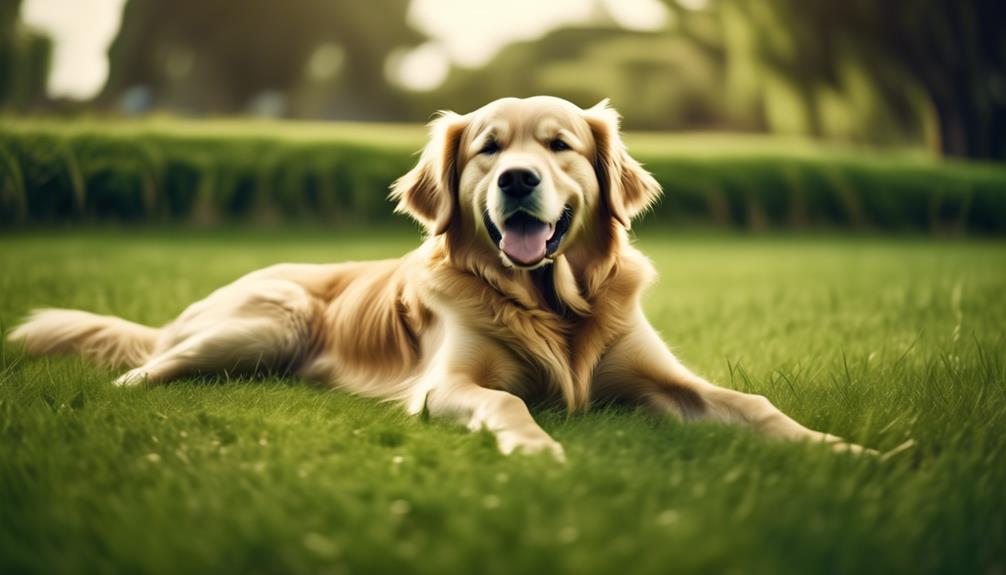As your dog gets older, they might not move as easily as they used to. It’s important to focus on mobility exercises to help them stay active and healthy.
Imagine helping your older pet stay strong and flexible by guiding them through exercises that focus on muscle strength, balance, and joint flexibility. Warm up their muscles with gentle stretching, work on balance and stability to prevent falls, and strengthen specific muscles to keep them feeling youthful.
While there’s no magic cure for the passage of time, with your support, your dog can enjoy a quality of life that’s rich and full, even as the years advance.
To discover how to adapt these workouts to your dog’s unique needs and continue nurturing their well-being, consider the specific approaches that can help you help them put their best paw forward.
Key Takeaways
- Gentle stretching routines and targeted muscle strengthening are important for maintaining flexibility and mobility in aging dogs.
- Balance and stability drills can enhance coordination, prevent falls, and support joint health.
- Starting with basic stretches and gradually increasing range of motion, using treats as positive reinforcement, and consulting with a veterinarian for tailored stretching routines are essential.
- Balance, consistency, and adjusting the exercise plan to the dog’s capabilities are more important than intensity.
Gentle Stretching Routines
To aid your aging dog in maintaining flexibility and mobility, begin by gently stretching their neck, shoulders, hips, and spine, always ensuring movements are slow and within their comfort range.
As senior dogs face the natural challenges of aging, including muscle loss and decreased physical activity, it’s vital to engage them in exercises that not only preserve but also enhance their well-being. Gentle stretching routines can be a cornerstone in this pursuit, providing a low-impact exercise option that helps strengthen their stabilizing muscles.
Take it slow, and observe your dog’s reactions to each stretch. Start with basic stretches, using treats as positive reinforcement to encourage their participation. As their guardian, you’re in the best position to ensure their exercise regimen is a positive experience. Gradually increase the range of motion, but never push beyond what seems comfortable for them.
A healthy body in senior dogs is about balance and consistency, not intensity.
Consulting with a veterinarian can give you the reassurance that the stretching routines are tailored to your dog’s unique needs. By investing this time and care, you’re supporting your companion’s quality of life, helping them remain agile and happy for as long as possible.
Balance and Stability Drills
As your dog enters their golden years, incorporating balance and stability drills into their routine can significantly enhance their coordination and prevent falls. It’s essential to lovingly address the unique needs of senior dogs, ensuring their exercise plan includes regular exercise tailored to their capabilities. Balance and stability drills are particularly beneficial, as they focus on strengthening problem areas and improving overall movement.
For dogs with conditions like hip dysplasia, which can worsen as a dog ages, these exercises support joint health and may alleviate discomfort. Start with simple exercises that challenge your dog’s balance, like lifting one paw at a time and holding it for a few seconds. This not only works their front legs but also engages their core muscles, promoting better stability.
Encourage your dog to stand on uneven surfaces, such as cushions, which require them to adjust their front feet and maintain equilibrium. This subtle yet effective drill can significantly improve their dexterity.
Targeted Muscle Strengthening
Focusing on targeted muscle strengthening, you’ll find that specific exercises designed to build and tone your aging canine’s muscles are critical for maintaining their vigor and mobility. As your dog advances into their golden years, their body’s needs will start to shift. To help your senior dogs remain fit and active, incorporating targeted muscle strengthening into their routine is essential.
Doing so not only supports their physical health but also nurtures the enduring bond you share.
- Watch their spirits lift as they regain confidence in their movements.
- Feel your heart warm knowing you’re providing the exercise to keep them spry.
- See the spark return to their eyes with every successful step they take.
- Savor the peace of mind that comes from knowing you’re offering helpful tips on caring for their well-being.
- Rejoice in the extra time spent together, guiding your dog to walk stronger each day.
Every dog is unique, and exercises should be tailored to their specific condition and abilities. Gradually introduce new activities, and always consult with a veterinarian or a canine physical therapist to ensure the exercises are appropriate and safe.
Frequently Asked Questions
How Can I Improve My Senior Dog’s Mobility?
To enhance your senior dog’s mobility, incorporate regular gentle exercises like swimming and leash walks. Engage them in obedience training on different surfaces and introduce lateral movements to strengthen their muscles and joints.
What Is the Best Exercise for a Senior Dog?
Swimming is the best exercise for your senior dog; it’s gentle on joints, boosts fitness, and maintains mobility without strain, showing you truly care for your furry friend’s health and happiness.
How Can I Help My Senior Dog Build Muscle?
To help your senior dog build muscle, engage them in regular gentle exercises like swimming, leash walks, and light fetch games, ensuring you adjust the intensity to their comfort and health level.
How Do You Exercise a Senior Dog’s Legs?
To exercise your senior dog’s legs, think of their routine as a gentle dance. Introduce side steps, encourage basic sits and stands, and sprinkle in short walks, ensuring each movement supports their aging limbs tenderly.


